History originally published in AutoWeek May 2, 1983
Ah, the clarity of hindsight. The perfect 20/20, read-the-union-bug-at-the-bottom-of-the-eye-chart ability to see what should have been seen, do what should have been done, especially when time has blurred a few inconsequential/important details.
Take, for example, the 1953-54 Corvette. It’s obvious by now that the Corvette should have been available with the V-8 from the very start. It’s easy to see that the automatic transmission-only policy was an error. The car should have been made with roll-up windows and a more weather-proof top. The handling should have been better, the styling a little less Captain Video. Perhaps then Chevrolet wouldn’t have found itself with 1,076 cars left unsold as on January 1, 1955.
Perhaps.
Consider the facts, though. First of all, Chevrolet’s stunning new small-block, destined to become the once and forever King of the hot rod set, was not in production until the 1955 model year. When it finally arrived – and not a minute too late – it was great. It’s difficult to power a car with an engine you don’t have.
A six didn’t seem like such a bad idea at the time: vee-engined sports cars were rare then. There were the hot rods: Curtis and Cunningham and Allard; and the European exotics: well, there was the Ferrari with the V-12 and the Pegaso with a DOHC V-8. Of course, none of these was a high-volume low-cost automobile.
Sports cars, at least sports cars which were produced in any number and at any price relatively reasonable, had in-line engines of four or six cylinders. The fours, like the MG TC/TD or the Crosley Hot Shot, were affordable. The sixes were a step up in price as well as performance. And just about everybody was building a six: Jaguar, Frazer-Nash, Aston Martin, AC, Talbot-Lago, Maserati, Mercedes… What if Chevrolet could bridge the gap, produce an inexpensive sports car with a six-cylinder engine? Kenosha’s sportster, the Nash-Healy, sold for $5,000, and it was powered by a Nash in-line six. GM could surely do as well. The six, then, was not as unlikely candidate seems in retrospect.
Thus the car came to have the Blue Flame Six. It originally had been designed as a truck engine introduced in 1941. For 1953, the Powerglide engine – it had been mated with Chevy’s automatic for passenger car use since 1950 – produced 115bhp at 3600 RPM. For the Corvette, however, it would be extensively modified. A high-lift cam with mechanical lifters was fitted along with special valves. Steel timing gears replaced the standard fiber gears, and double valve springs allowed higher rpm. Compression ratio was bumped from 7.5:1 to 8.0:1. Most noticeable are the three side-draft Carter carburetors with their bullet-shaped air cleaners. It all served to boost power output to a not unrespectable 150 BHP.
What about the automatic transmission? The official line is that the general buying public was moving from the “austerity” of manual shift to the “luxury” of a modern – read automatic – transmission. Considering the austerity of the Corvettes poor weather sealing, its side curtains and dubious top, it sounds more like a rationalization. After all, a standard transmission could have been adapted to the normally automatic-equipped engine, thereby leaving it up to the customer to decide which he preferred. Chevrolet, however, opted simply to modify the two-speed automatic to withstand the Blue Flame’s enhanced torque by increasing the line pressure. It was a short cut to getting the car into production.
The decision on the weather sealing seems a little tougher to rationalize. In comparison with other sports cars on the market, especially the popular T-series, the Corvette was not that bad. After all, one was supposed to expect the leaky top and inconvenience of side curtains with a sports car.
The styling, which had been such a hit at the Motorama shows, is dated today. It’s almost a little embarrassing, sort of like explaining that, yes, that funny looking kid in the high school yearbook really was you. At least for the Corvette the proportions were right. The peculiarity of the styling was mostly in detail: the “wrong way” wing on the chrome rub strip along the side, or the rocket fins around the taillights. The wire mesh over the headlights was a compromise. Original plans called for Plexiglas covers.
The overall favorable appearance of the Corvette was made possible by the new frame on which the car was based. Although intentions had been to use a stock sedan chassis to keep costs down, Chevrolet styling’s Robert McLean developed a design calling for a new frame using only stock pieces here and there. The under-$2000 sedan-matching price went out the window. The bonus of the new frame, though, was the placement of the engine 3 inches lower and 7 inches further back than in a Chevrolet sedan. This improved the balance to 53 front/47 rear and lowered the center of gravity to 18 inches.
While the potential for good handling was there, however, the car fell somewhat short in practice. The car, as Zora Arkus-Duntov later commented, had a front geometry which promoted oversteer and a rear geometry that gave understeer. This, needless to say, creates more than a bit of uncertain handling as AutoWeek learned while recently driving a polo white 1954 Corvette belonging to Howard Dabney. Not only is there a vagueness that urges you not to push too hard for fear of what lies just beyond, but the car is very susceptible to nibbling. Nibbling? Heck, it makes Pac-Man look like a piker. It goes after uneven paving seams like a hunger striker with a change of heart. The steering wheel is big in the best dirt tracker tradition, but the car just lacks that appetite for corner carving that anything calling itself a sports car must have.
Acceleration isn’t bad. The six won’t press you back into the seat, nor does it even feel all that quick, but zero-to-60 mph comes in 11 seconds. That’s off the pace of an XK-120 maybe, but it was at least as fast as any production automobile in the US, though not better. The two-speed automatic actually makes the car feel slower. The transmission can be shifted manually, and, in fact, it works best that way, but there’s not a lot to do. You can’t even push in a clutch pedal when you make your one and only shift. Nonetheless, shifts must be made with care. The shifter is merely a wire rod attached to a shaft exiting the side of the transmission pump. It has a flimsy feel, the detents are soft, and “Reverse” is the next step beyond “Second.” There is no selector to guide gear choice, so one had best be of delicate hand to avoid scattering transmission parts all over the highway.
Perhaps the most notable feature of the car is a its exhaust note, a burbly bubbly sound from the dual pipes that, combined with the hissing, water-off-a-hull sound from over the top of the windshield at 40 mile-per-hour-plus, gives an almost nautical sensation. Let Ferrari V-12’s rip canvas. The Blue Flame Six will be forever blowing bubbles. And that, one supposes, is how it ought to be. The Chevrolet Corvette has now entered its fourth decade, and during its history the ‘Vette has been everything from a hot-breath, ragged-maned racer to a detoxed boulevard cruiser for accountants. Surely there is room there for a handful of pleasant polo white sportsters. One could look back on much worse.








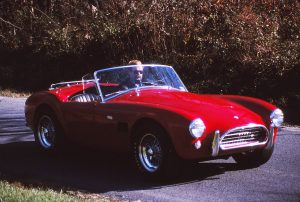
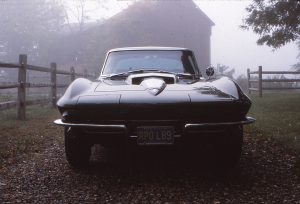
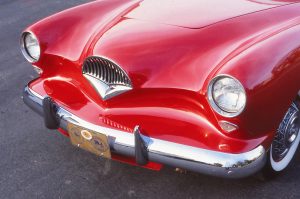
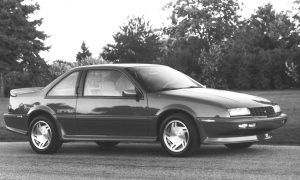

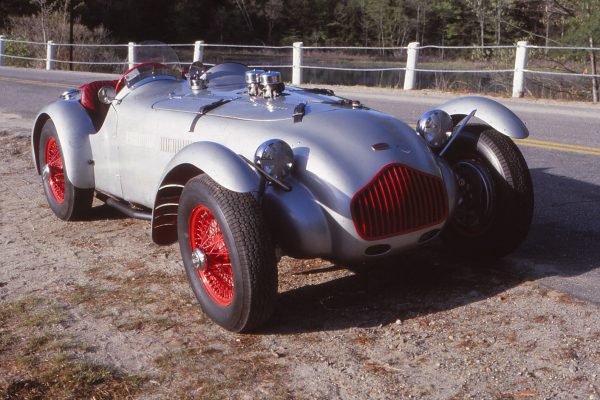
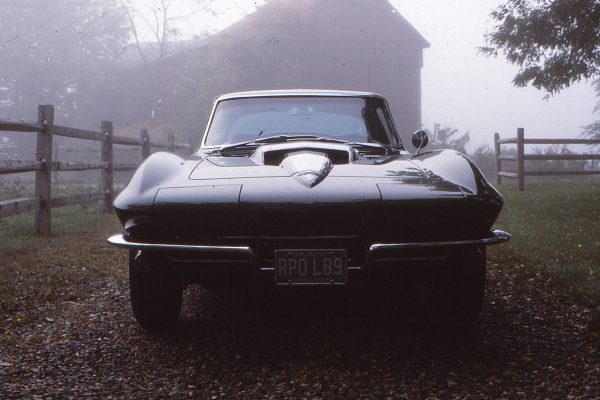
a few years ago there was a kit to convert a new vette to a series 1 lookalike…
actually quite well done…